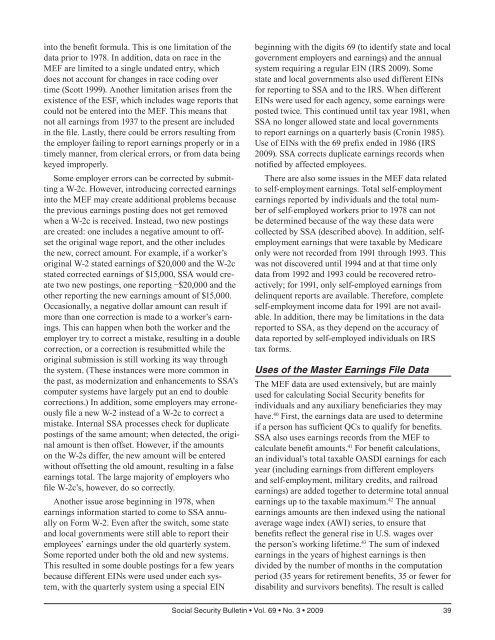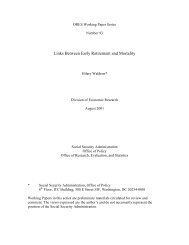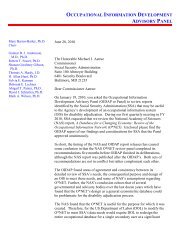prior to 1950, first year of earnings after 1950, andlast year of earnings (Panis and others 2000). Thissegment summarizes all the OASDI- and HI-taxableearnings since 1978 as reported in the Detail Segmentand also contains all reported taxable earningsby tax year. Taxable earnings from more than oneemployer are summarized into one yearly total. Forexample, if an individual earned $20,000 from eachof two different employers, the total earnings wouldbe listed as $40,000 (thus individuals with more thanone employer may have earnings that exceed the taxablemaximum). The Summary Segment contains noinformation on employers.The Earnings Detail Segment includes annual W-2–level data from each of a worker’s employers since1978, as well as self-employment earnings informationfrom the Schedule SE. The W-2 information includesthe employer identification number (EIN), 37 OASDIand Medicare taxable wages, and total wages reportableas IRS-taxable income on Form 1040 (currentlyshown in Box 1 of Form W-2, this amount includeswages above the OASDI taxable maximum, noncoveredwages, and deferred-compensation distributions,but does not include deferred-compensation contributions).Information from delinquent or correctedW-2s (W-2c’s) is included in separate records in theDetail Segment. 38 Information from self-employmentpostings includes the OASDI and Medicare taxableearnings, but does not indicate deferred-compensationcontributions. Detail Segment records also containadditional variables pertaining to types of posting.These include an Earnings Report Type (ERT)code, indicating earnings categories such as covered,noncovered, delinquent, self-employment, and unreportedtips; and an Earnings Type of Employment(EET) code, which indicates employment categoriessuch as regular, military, self-employed, agricultural,nonprofit, state and local government, household,railroad, MQGE, and workers with tip income (Panisand others 2000). As of December 2005, about threefourthsof earnings in the MEF Detail Segment weretaxable wages from Form W-2, with the rest consistingof noncovered W-2 wages, self-employment income,and delinquent W-2 earnings. From 1978 through2005, about three-quarters of wages came from regularemployment, while most of the rest came from tipsand from employment in the military, state and localgovernment, agriculture, households, and railroads(Pattison 2007). 39When the Detail Segment process was establishedin 1978, only two amounts were taken from the W-2:OASDI-taxable earnings (to be added into each person’ssummary earnings record) and the IRS-taxablewage (to be reported on Form 1040 and used incalculating the national average wage). There are stillonly two dollar fields on each Detail Segment record;so, in order to handle the information available onmore recent W-2s, multiple records may be generatedfrom a single W-2. The initial detail posting, calledthe primary wage posting, will contain two dollarvalues: wages subject to federal income taxes (includingamounts paid under deferred-compensation plans)and OASDI-taxable earnings. Additional MEF recordsare created for a W-2 if it includes earnings above the<strong>Social</strong> <strong>Security</strong>–taxable maximum in 1991 and later(the excess earnings would be HI-taxable), deferredcompensation in 1990 and later, or tips. Additionalrecords are also created for corrected W-2s (W-2c’s).For example, in 2003, the OASDI-taxable maximumwas $87,000 and for a worker earning $100,000,two records would be generated. The primary wageposting would show IRS-taxable earnings of $100,000in the IRS taxable field and OASDI-taxable earningsof $87,000 in the OASDI/HI field. A secondary wageposting for HI-taxable earnings would have $0 in theIRS field and $13,000 in the OASDI/HI field representingHI-taxable earnings above the OASDI-taxablemaximum. The OASDI/HI field can be used for otherpurposes as well, such as OASDI- and/or HI-taxabletips. The ERT and EET indicators show the type ofearnings and employment represented in each of thefields in each posting. Depending on the informationin an individual’s W-2, there may be a single MEFdetail record or there may be many records to accountfor multiple employers, earnings over the taxablemaximum, or other types of earnings including tips,HSAs, or deferred compensation.Limitations and ComplexitiesAs shown above, the SSA Master Earnings Filecontains extensive historical data on U.S. earnings.However, as with all data sets—especially administrativedata sets—there are some limitations andcomplexities that researchers must acknowledge(although it is important to note that these limitationsdo not preclude SSA from properly administering theprogram or determining benefit eligibility or benefitamounts). Foremost, earnings data were first collectedfor the sole purpose of computing <strong>Social</strong> <strong>Security</strong>benefits. In the earlier years, only data on earningsup to the OASDI-taxable maximum were collectedbecause any earnings over this amount did not factor38 <strong>Social</strong> <strong>Security</strong> Bulletin • Vol. 69 • No. 3 • 2009
into the benefit formula. This is one limitation of thedata prior to 1978. In addition, data on race in theMEF are limited to a single undated entry, whichdoes not account for changes in race coding overtime (Scott 1999). Another limitation arises from theexistence of the ESF, which includes wage reports thatcould not be entered into the MEF. This means thatnot all earnings from 1937 to the present are includedin the file. Lastly, there could be errors resulting fromthe employer failing to report earnings properly or in atimely manner, from clerical errors, or from data beingkeyed improperly.Some employer errors can be corrected by submittinga W-2c. However, introducing corrected earningsinto the MEF may create additional problems becausethe previous earnings posting does not get removedwhen a W-2c is received. Instead, two new postingsare created: one includes a negative amount to offsetthe original wage report, and the other includesthe new, correct amount. For example, if a worker’soriginal W-2 stated earnings of $20,000 and the W-2cstated corrected earnings of $15,000, SSA would createtwo new postings, one reporting −$20,000 and theother reporting the new earnings amount of $15,000.Occasionally, a negative dollar amount can result ifmore than one correction is made to a worker’s earnings.This can happen when both the worker and theemployer try to correct a mistake, resulting in a doublecorrection, or a correction is resubmitted while theoriginal submission is still working its way throughthe system. (These instances were more common inthe past, as modernization and enhancements to SSA’scomputer systems have largely put an end to doublecorrections.) In addition, some employers may erroneouslyfile a new W-2 instead of a W-2c to correct amistake. Internal SSA processes check for duplicatepostings of the same amount; when detected, the originalamount is then offset. However, if the amountson the W-2s differ, the new amount will be enteredwithout offsetting the old amount, resulting in a falseearnings total. The large majority of employers whofile W-2c’s, however, do so correctly.Another issue arose beginning in 1978, whenearnings information started to come to SSA annuallyon Form W-2. Even after the switch, some stateand local governments were still able to report theiremployees’ earnings under the old quarterly system.Some reported under both the old and new systems.This resulted in some double postings for a few yearsbecause different EINs were used under each system,with the quarterly system using a special EINbeginning with the digits 69 (to identify state and localgovernment employers and earnings) and the annualsystem requiring a regular EIN (IRS 2009). Somestate and local governments also used different EINsfor reporting to SSA and to the IRS. When differentEINs were used for each agency, some earnings wereposted twice. This continued until tax year 1981, whenSSA no longer allowed state and local governmentsto report earnings on a quarterly basis (Cronin 1985).Use of EINs with the 69 prefix ended in 1986 (IRS2009). SSA corrects duplicate earnings records whennotified by affected employees.There are also some issues in the MEF data relatedto self-employment earnings. Total self-employmentearnings reported by individuals and the total numberof self-employed workers prior to 1978 can notbe determined because of the way these data werecollected by SSA (described above). In addition, selfemploymentearnings that were taxable by Medicareonly were not recorded from 1991 through 1993. Thiswas not discovered until 1994 and at that time onlydata from 1992 and 1993 could be recovered retroactively;for 1991, only self-employed earnings fromdelinquent reports are available. Therefore, completeself-employment income data for 1991 are not available.In addition, there may be limitations in the datareported to SSA, as they depend on the accuracy ofdata reported by self-employed individuals on IRStax forms.Uses of the Master Earnings File DataThe MEF data are used extensively, but are mainlyused for calculating <strong>Social</strong> <strong>Security</strong> benefits forindividuals and any auxiliary beneficiaries they mayhave. 40 First, the earnings data are used to determineif a person has sufficient QCs to qualify for benefits.SSA also uses earnings records from the MEF tocalculate benefit amounts. 41 For benefit calculations,an individual’s total taxable OASDI earnings for eachyear (including earnings from different employersand self-employment, military credits, and railroadearnings) are added together to determine total annualearnings up to the taxable maximum. 42 The annualearnings amounts are then indexed using the nationalaverage wage index (AWI) series, to ensure thatbenefits reflect the general rise in U.S. wages overthe person’s working lifetime. 43 The sum of indexedearnings in the years of highest earnings is thendivided by the number of months in the computationperiod (35 years for retirement benefits, 35 or fewer fordisability and survivors benefits). The result is called<strong>Social</strong> <strong>Security</strong> Bulletin • Vol. 69 • No. 3 • 2009 39
- Page 1 and 2: Social SecuritySocial SecurityBulle
- Page 3: Social SecurityBulletin Vol. 69, No
- Page 6 and 7: Perspectives77 An Empirical Study o
- Page 8 and 9: Selected Abbreviations—continuedM
- Page 10: within the next few years (Aglira 2
- Page 14 and 15: coverage varies significantly by ra
- Page 16 and 17: non-Hispanic white, and college edu
- Page 18 and 19: same groups (Table 6). For the last
- Page 20 and 21: from DB to DC pensions is accelerat
- Page 22 and 23: Table 8.Percent of individuals who
- Page 24 and 25: not necessarily the largest gains a
- Page 26 and 27: shoring-up DB plans before those pl
- Page 28 and 29: Table B-1.Percent change in mean pe
- Page 30 and 31: Table B-3.Percent of individuals wh
- Page 32 and 33: ReferencesAaronson, Stephanie, and
- Page 35 and 36: Social Security Administration’s
- Page 37: Chart 1.Historical expansion of Soc
- Page 40 and 41: self-employment information for the
- Page 42 and 43: (Cronin 1985). The final earnings r
- Page 46 and 47: average indexed monthly earnings (A
- Page 48 and 49: 13For an explanation of how the sel
- Page 50 and 51: Kopczuk, Emmanuel Saez, and Jae Son
- Page 53 and 54: Occupations of SSI Recipients Who W
- Page 55 and 56: on the differences between the occu
- Page 57 and 58: prediction models. Table A-1 lists
- Page 59 and 60: Occupational Distributions of theEm
- Page 61 and 62: similar, only 4 percent of the popu
- Page 63 and 64: Table 5.Estimated occupational dist
- Page 65 and 66: Table 7.Predicted Herfindahl-Hirsch
- Page 67 and 68: Table 9.Estimated occupational dist
- Page 69 and 70: Table 11.Average annual wages of wo
- Page 71 and 72: Table A-2.Means and standard errors
- Page 73 and 74: Table A-3.Coefficients and standard
- Page 75 and 76: Table A-3.Coefficients and standard
- Page 77 and 78: Table A-3.Coefficients and standard
- Page 79 and 80: management, professional, and relat
- Page 81: Stapleton, David C., Nanette Goodma
- Page 84 and 85: Selected Abbreviations—continuedO
- Page 86 and 87: The 1983 Amendments to the Social S
- Page 88 and 89: Chart 1.Proportion of new claimants
- Page 90 and 91: Table 4.The evolution of the ARF an
- Page 92 and 93: for the test of equality of means b
- Page 94 and 95:
Table 8.Average monthly Social Secu
- Page 96 and 97:
in the chart, especially for men, t
- Page 98 and 99:
6This is a very important character
- Page 100 and 101:
Benítez-Silva, Hugo, Berna Demiral
- Page 103 and 104:
OASDI and SSI Snapshot andSSI Month
- Page 105 and 106:
Monthly Statistical Snapshot, Augus
- Page 107 and 108:
Table 2.Recipients, by eligibility
- Page 109 and 110:
SSI Federally Administered Payments
- Page 111 and 112:
Table 7.Average monthly payment, by
- Page 113:
Awards of SSI Federally Administere
- Page 116 and 117:
Copyright—Authors are responsible
- Page 119 and 120:
Program Highlights, 2009Old-Age, Su








